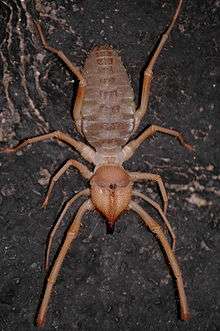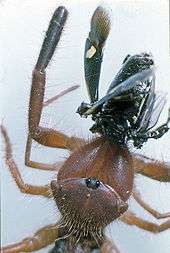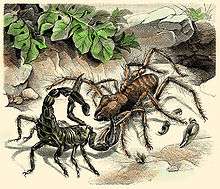Solifugae
Solifugae is an order of animals in the class Arachnida known variously as camel spiders, whip scorpions, sun spiders, or solifuges. The order includes more than 1,000 described species in about 153 genera. Despite the common names, they are neither true scorpions (order Scorpiones) nor true spiders (order Araneae). Much like a spider, the body of a solifugid has two tagmata: an opisthosoma, or abdomen, behind the prosoma, or cephalothorax (However, there is currently neither fossil nor embryological evidence that arachnids ever had a separate thorax-like division, so the validity of the term cephalothorax, which means a fused cephalon, or head, and thorax, has been questioned. There are also arguments against use of 'abdomen', as the opisthosoma of many arachnids contains organs atypical of an abdomen, such as a heart and respiratory organs.[2]). At the front end, the prosoma bears two chelicerae that, in most species, are conspicuously large. The chelicerae serve as jaws and in many species also are used for stridulation. Unlike scorpions, solifugids do not have a third tagma that forms a "tail". Most species of Solifugae live in dry climates and feed opportunistically on ground-dwelling arthropods and other small animals. The largest species grow to a length of 12–15 cm (5–6 in), including legs. A number of urban legends exaggerate the size and speed of the Solifugae, and their potential danger to humans, which is negligible.
| Solifugae | |
|---|---|
 | |
| Solifugid from Arizona | |
| Scientific classification | |
| Kingdom: | Animalia |
| Phylum: | Arthropoda |
| Subphylum: | Chelicerata |
| Class: | Arachnida |
| Order: | Solifugae Sundevall, 1833 |
| Families | |
| |
Anatomy
Solifugae are moderately small to large arachnids (a few millimeters to several centimeters in body length), with the larger species reaching 12–15 cm (5–6 in) in length, including legs.[3][4] In practice, the respective lengths of the legs of various species differ drastically, so the resulting figures are often misleading. More practical measurements refer primarily to the body length, quoting leg lengths separately, if at all. The body length is up to 7 cm (3 in).[5][6] Most species are closer to 5 cm (2 in) long, and some small species are under 1 cm (0.4 in) in head-plus-body length when mature.[7]
Like that of the spider order, the Araneae, the body plan of the Solifugae has two main tagmata: the prosoma, or cephalothorax, is the anterior tagma, and the 10-segmented abdomen, or opisthosoma, is the posterior tagma. As shown in the illustrations, the solifugid prosoma and opisthosoma are not separated by nearly as clear a constriction and connecting tube or "pedicel" as occurs in "true spiders", the order Araneae. The lack of the pedicel reflects another difference between the Solifugae and spiders, namely that solifugids lack both spinnerets and silk, and do not spin webs. Spiders need considerable mobility of their abdomens in their spinning activities, and the Solifugae have no need for any such adaptation.
The prosoma comprises the head, the mouthparts, and the somites that bear the legs and the pedipalps. Though it is not split into two clear tagmata, the prosoma does have a large, relatively well-defined anterior carapace, bearing the animal's eyes and chelicerae, while a smaller posterior section bears the legs.[7][8]
Like pseudoscorpions and harvestmen, the Solifugae lack book lungs, having instead a well-developed tracheal system that inhales and exhales air through a number of spiracles; one pair between the second and third pair of walking legs, two pairs on the abdomen on abdominal segments three and four, and an unpaired spiracle on the fifth abdominal segment.[9]
Chelicerae
Among the most distinctive features of the Solifugae are their large chelicerae, which in many species are longer than the prosoma. Each of the two chelicerae has two articles (segments, parts connected by a joint),[10] forming a powerful pincer, much like that of a crab; each article bears a variable number of teeth, largely depending on the species.[7][8] The chelicerae of many species are surprisingly strong; they are capable of shearing hair or feathers from vertebrate prey or carrion, and of cutting through skin and thin bones such as those of small birds.[11] Many Solifugae stridulate with their chelicerae, producing a rattling noise.[4]
Legs and pedipalps
_1600.jpg)
Like most other arachnids, although Solifugae appear to have five pairs of legs, only the hind four pairs actually are "true" legs. Each true leg has seven segments: coxa, trochanter, femur, patella, tibia, metatarsus, and tarsus.[11][12]
The first, or anterior, of the five pairs of leg-like appendages are not "actual" legs, but pedipalps, and they have only five segments each. The pedipalps of the Solifugae function partly as sense organs similar to insects' antennae, and partly in locomotion, feeding, and fighting. In normal locomotion, they do not quite touch the ground, but are held out to detect obstacles and prey; in that attitude, they look particularly like an extra pair of legs or perhaps arms. Reflecting the great dependence of the Solifugae on their tactile senses, their anterior true legs commonly are smaller and thinner than the posterior three pairs. That smaller anterior pair acts largely in a sensory role as a supplement to the pedipalps, and in many species they accordingly lack tarsi. At the tips of their pedipalps, Solifugae bear eversible adhesive organs, which they may use to capture flying prey, and which at least some species certainly use for climbing smooth surfaces.[11][13]
For the most part, only the posterior three pairs of legs are used for running.[8][11] On the undersides of the coxae and trochanters of the last pair of legs, Solifugae have fan-shaped sensory organs called malleoli or racquet (or racket) organs. Sometimes, the blades of the malleoli are directed forward, sometimes not. They have been suspected to be sensory organs for the detection of vibrations in the soil, perhaps to detect threats and potential prey or mates.[11] These structures may be chemoreceptors.[14]
Males are usually smaller than females, with relatively longer legs.[4] Unlike females, the males bear a pair of flagella, one on each chelicera. In the accompanying photograph of a male solifugid, one flagellum is just visible near the tip of each chelicera. The flagella, which bend back over the chelicerae, are sometimes called horns and are believed to have some sexual connection, but their function has not yet been clearly explained.[11]
Eyes
Some species have very large central eyes. They look like simple eyes or ocelli, and are surprisingly sophisticated. They can recognise forms, and are used in hunting and avoiding enemies. These eyes are remarkable in their internal anatomy; they may represent the last step in the integration of the aggregate of simple ocelli into a compound eye, and of further integration of a compound eye into a simple eye.[15] In contrast, lateral eyes are absent in many species, and where they are present at all, they are only rudimentary.
Classification
The Solifugae are an order of their own, though are sometimes confused with spiders, which form a completely distinct order, the Araneae. The order comprises over 1000 described species in 153 genera assigned to the following 12 families:[16]:213
- Ammotrechidae
- Ceromidae
- Daesiidae
- Eremobatidae
- Galeodidae
- Gylippidae
- Hexisopodidae
- Karschiidae
- Melanoblossidae
- Mummuciidae[17]
- Rhagodidae
- Solpugidae
The family Protosolpugidae is only known from one fossil species from the Pennsylvanian.
Ecology

Although the Solifugae are considered to be endemic indicators of desert biomes,[7]:1 they occur widely in semidesert and scrub. Some species also live in grassland or forest habitats. Solifugae generally inhabit warm and arid habitats, including virtually all warm deserts and scrublands in all continents except Antarctica and Australia.[4]
Solifugae are carnivorous or omnivorous, with most species feeding on termites, darkling beetles, and other small, ground-dwelling arthropods. Solifuges are aggressive hunters and voracious opportunistic feeders and have been recorded as feeding on snakes, small lizards, birds, and rodents.[7][18] Prey is located with the pedipalps and killed and cut into pieces by the chelicerae. The prey is then liquefied and the liquid ingested through the pharynx. Although they do not normally attack humans, their chelicerae can penetrate human skin, and painful bites have been reported.[4]
Various other predators, such as the large slit-faced bat, scorpions, toads, and insectivores, may prey on Solifugae.
Life cycle
Solifugae are typically univoltine (reproducing once a year).[7]:8 Reproduction can involve direct or indirect sperm transfer; when indirect, the male emits a spermatophore on the ground and then inserts it with his chelicerae in the female's genital pore. To do this, he flings the female on her back.
The female then digs a burrow, into which she lays 50 to 200 eggs – some species then guard them until they hatch. Because the female does not feed during this time, she will try to fatten herself beforehand, and a species of 5 cm (2.0 in) has been observed to eat more than 100 flies during that time in the laboratory.[4] Solifugae undergo a number of stages including, egg, postembryo, 9–10 nymphal instars, and adults.[7]
Etymology
The name Solifugae derives from Latin, and means "those that flee from the sun". The order is also known by the names Solpugida, Solpugides, Solpugae, Galeodea, and Mycetophorae. Their common names include camel spider, wind scorpion, scorpion carrier, jerrymunglum,[19] sun scorpion, and sun spider. In southern Africa, they are known by a host of names, including red romans, haarskeerders ("hair cutters") and baardskeerders ("beard cutters"), the latter two relating to the belief they use their formidable jaws to clip hair from humans and animals to line their subterranean nests.[20]
Solifugids and humans

Solifugids have been recognised as distinct taxa from ancient times. The Greeks recognized that they were distinct from spiders; spiders were called ἀράχναι (arachnai) while Solifugae were named φαλάγγια (phalangia). In Aelian's De natura animalium, they are mistakenly mentioned, along with scorpions, as responsible for the abandoning of a country in Ethiopia.[21] Anton August Heinrich Lichtenstein theorised in 1797 that the "mice" that plagued the Philistines in the Old Testament were Solifugae. During World War I, troops stationed in Abū Qīr, Egypt, would stage fights between captive "jerrymanders," as they referred to them, and placed bets on the outcome. Similarly, British troops stationed in Libya in World War II would stage fights between solifugids and scorpions.[7]:2–3
Urban legends
Solifugae are the subject of many legends and exaggerations about their size, speed, behaviour, appetite, and lethality. They are not especially large, the biggest having a leg span of about 12 cm (4.7 in).[4] They are fast on land compared to other invertebrates, with their top speed estimated to be 16 km/h (10 mph),[3] close to half as fast as the fastest human sprinter.[22]
The Solifugae apparently have neither venom glands nor any venom-delivery apparatus such as the fangs of spiders, stings of wasps, or venomous setae of caterpillars (e.g., Lonomia or Acharia species).[23] One 1978 study is frequently quoted, in which the authors report detection of an exception in India, in that Rhagodes nigrocinctus had venom glands, and that injection of the secretion into mice was frequently fatal. However, no supporting studies have confirmed either statement, such as by independent detection of the glands as claimed, or the relevance of the observations, if correct. Even the authors of the original account denied having found any means of delivery of the putative venom by the animal, and the only means of administering the material to the mice was by parenteral injection.[24] Given that many non-venoms such as saliva, blood and glandular secretions can be lethal if injected, and that no venomous function was even speculated upon in this study, there is still no evidence for even one venomous species of solifugid.[23]
Because of their unfamiliar spider-like appearance and rapid movements, Solifugae have startled or even frightened many people. This fear was sufficient to drive a family from their home when one was allegedly discovered in a soldier's house in Colchester, England, and caused the family to blame the solifugid for the death of their pet dog.[25] An Arizona resident developed painful lesions due to a claimed solifugid bite but could not produce a specimen for confirmation.[26] Though they are not venomous, the powerful chelicerae of a large specimen may inflict a painful nip, but nothing medically significant.[27]
References
- "PBDB". Solifugae (camel spider).
- Shultz, Stanley; Shultz, Marguerite (2009). The Tarantula Keeper's Guide. Hauppauge, New York: Barron's. p. 23. ISBN 978-0-7641-3885-0.
- "Egyptian giant solpugid (camel spider) Galeodes arabs". National Geographic. Retrieved June 10, 2011.
- G. Schmidt (1993). Giftige und gefährliche Spinnentiere (in German). Westarp Wissenschaften. ISBN 3-89432-405-8.
- Pechenik, Jan (1996). Biology of the Invertebrates. Dubuque: Wm. C. Brown Publishers. ISBN 0-697-13712-0.
- Mullen, Gary R. (2009). Medical and Veterinary Entomology (2 ed.). Burlington, Massachusetts: Academic Press. ISBN 978-0-12-372500-4.
- Fred Punzo (1998). The Biology of Camel-Spiders. Springer. ISBN 0-7923-8155-6. Retrieved January 25, 2010.
- Barnes, Robert D. (1982). Invertebrate Zoology. Philadelphia, PA: Holt-Saunders International. pp. 613–614. ISBN 0-03-056747-5.
- Multicellular Animals: Volume II: The Phylogenetic System of the Metazoa
- Brown, Lesley (1993). The New shorter Oxford English dictionary on historical principles. Oxford: Clarendon Press. ISBN 0-19-861271-0.
- Holm, Erik; Dippenaar-Schoeman, Ansie (2010). Goggo Guide: The arthropods of southern Africa. Pretoria: LAPA Publishers. ISBN 0799346896.
- Filmer, Martin (1997). Southern African Spiders. City: BHB International / Struik. ISBN 1-86825-188-8.
- Harmer, Sir Sidney Frederic; Shipley, Arthur Everett et alia: The Cambridge natural history Volume 4, Crustacea, Trilobites, Arachnida, Tardigrada, Pentastomida etc. Macmillan Company 1895
- Punzo, Fred (1998). The Biology of Camel-Spiders: Arachnida, Solifugae. Boston, MA: Springer US. p. 66. ISBN 9781461557272. Retrieved 21 November 2015.
- Beklemishev, Vladimir (1969). Principles of Comparative Anatomy of Invertebrates. Chicago: University of Chicago Press. ISBN 0226041751.
- Levin, Simon A. (2001). Encyclopedia of biodiversity, Volume 1. 2001: Academic Press. p. 943. ISBN 978-0-12-226866-3.CS1 maint: location (link)
- "Two New Species of the Sun-spider Genus Gaucha (Solifugae, Mummuciidae) from Argentina and Brazil". Novataxa. Retrieved 11 February 2019.
- Valdez, Jose W. "Arthropods as vertebrate predators: A review of global patterns". Global Ecology and Biogeography. n/a (n/a). doi:10.1111/geb.13157. ISSN 1466-8238.
- Skaife, Sydney Harold; South African Nature Notes, Second edition. Pub: Maskew Miller: Cape Town, 1954.
- Ross Piper (2007). Extraordinary Animals: An Encyclopedia of Curious and Unusual Animals. Greenwood Press.
- "Aelian, NA. 17.40". attalus.org. Retrieved March 6, 2019. - where they are called "four-jawed spiders".
- "IAAF (International Association of Athletics Federations) Biomechanical Research Project: Berlin 2009" (PDF). Archived from the original (PDF) on 2014-05-14. Retrieved 2013-11-18.
- Klann, Anja Elisabeth. Histology and ultrastructure of solifuges comparative studies of organ systems of solifuges (Arachnida, Solifugae) with special focus on functional analyses and phylogenetic interpretations Dissertation: Greifswald, Univ., Diss., 2009 Edition/Format:Thesis/dissertation Manuscript: eBook Archival Material: English View all editions and formats Database:WorldCat.
- M. Aruchami & G. Sundara Rajulu (1978). "An investigation on the poison glands and the nature of the venom of Rhagodes nigrocinctus (Solifugae: Arachnida)". Natl. Acad. Sci. Lett. 1: 191–192.
- "Paratrooper's family flees home after Afghan spider 'kills dog'". The Guardian. August 28, 2008. Retrieved August 1, 2019.
- "Mystery bug bite leaves Arizona man covered in bruises, 'excruciating pain'". Global News. July 27, 2017. Retrieved July 27, 2017.
- David Penney (2009). "Solifugae (camel spiders)". Common Spiders and Other Arachnids of The Gambia, West Africa. Siri Scientific Press. p. 71. ISBN 978-0-9558636-3-9.
Videos
Camel Spider Feeding by Stefan F. Wirth
External links
| Wikimedia Commons has media related to Solifugae. |
| Wikispecies has information related to Solifugae |
- "The Arachnid Order Solifugae". Warren Savary.
- Mikkelson, Barbara & David P. "Camel Spiders" at Snopes.com: Urban Legends Reference Pages.
- "Camel Spiders: Behind an E-Mail Sensation From Iraq". National Geographic. June 29, 2004.